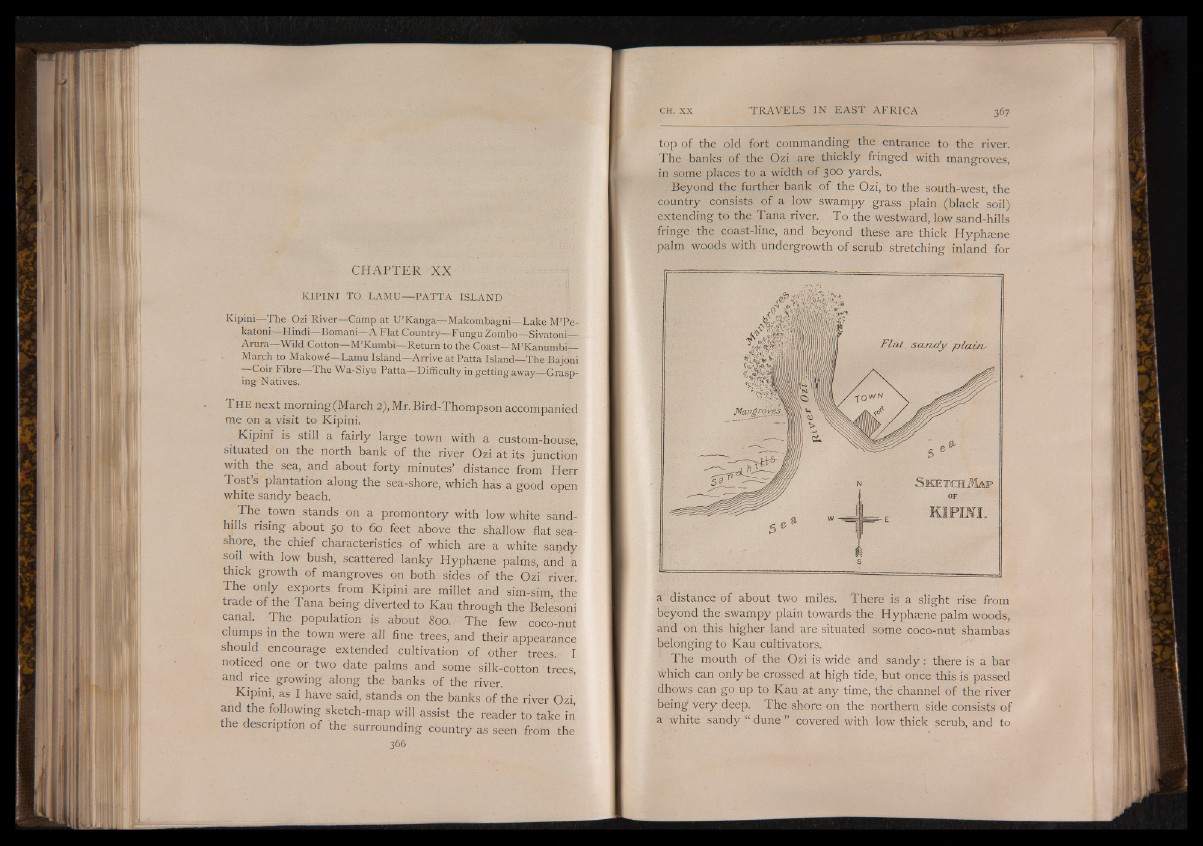
CHAPTER XX
KIP IN'I TO LAMU— FATTA ISLAND
Kipini— The Ozi River—Camp at U’Kanga— Makombagni— Lake M’Pe-
katoni— Hindi— Bomani—A Flat Country— Fungu Zombo -Sivatoni —
Arura—Wild Cotton— M’Kumbi— Return to the Coast— M’Kanumbi-
March to Makowd— Lamu Island—.Arrive at Patta Island— The Bajoni
— Coir Fibre— The Wa-Siyu Patta— Difficulty in getting awaylsGrasp-
ing Natives.
T h e next morning (March 2), Mr. Bird-Thompson accompanied
me on a visit to Kipini.
Kipini is still a fairly large town with a custom-house,
situated on the north bank of the river Ozi at its junction
with the sea, and about forty minutes’ distance from Herr
Tosts plantation along the sea-shore, which has a good open
white sandy beach.
h-*wn ;stands on a promontory with low white sand-
hills rising about 50 to 60 feet above the shallow flat seashore,
the chief characteristics of which are a white sandy
soil with low bush, scattered la-nky Hyphsene palms, and a
thick growth of mangroves on both sides of the Ozi river.
The only exports from Kipini are millet and sim-sim, the
trade of the Tana being diverted to Kau through the Belesoni
canal. The population is about 800.' The few coco-nut
clumps in the town were all fine trees, and their appearance
should encourage extended cultivation of other trees. I
noticed one or two date palms and some silk-cotton trees,
and rice growing along the banks of the river.
Kipini, as I have said, stands on the banks of the river Ozi,
and the following sketch-map will assist the reader to take in
the description of the surrounding country as seen from the
366
top of the old fort commanding the entrance to the river.
The banks of the Ozi are thickly fringed with mangroves,
in some places to a width of 300 yards.
Beyond the further bank of the Ozi, to the south-west, the
country consists of a low swampy grass plain (black soil)
extending to the Tana river. To the westward, low sand-hills
fringe the coast-line, and beyond these are thick Hyphsene
palm woods with undergrowth of scrub stretching inland for
a distance of about two miles. There is a slight rise from
beyond the swampy plain towards the Hyphaene palm woods,
and on this higher land are situated some coco-nut shambas
belonging to Kau cultivators.
The mouth of the Ozi is wide and sandy: there is a bar
which can only be crossed at high tide, but once this is passed
dhows can go up to Kau at any time, the channel of the river
being very deep. The shore on the northern side consists of
a white sandyj“ dune | covered with low thick scrub, and to